*NURSING > QUESTIONS & ANSWERS > NUTRI 228 Week 1 - Quiz 1 (All)
NUTRI 228 Week 1 - Quiz 1
Document Content and Description Below
Question 1.Question : (TCO 1) Which statement is FALSE concerning the field of nutrition? Student Answer: Nutrition is the study of how food nourishes the body. Nutrition encompasses how we consu... me, digest, metabolize, and store food. Nutrition is an ancient science that dates back to the fourteenth century. Nutrition involves studying the factors that influence eating patterns. Instructor Explanation: Chapter 1 Points Received: 2 of 2 Comments: Question 2.Question : (TCO 1) ________ refers to eating the right proportion of foods. Student Answer: RestrictionBalance Moderation Variety Instructor Explanation: Chapter 2 Points Received: 0 of 2 Comments: Question 3.Question : (TCO 1) What is at the base of the Healthy Eating Pyramid? Student Answer: Bread, cereal, rice, and pasta Low-fat dairy foods Fruits and vegetables Daily exercise and weight control Instructor Explanation: Chapter 2 Points Received: 2 of 2 Comments: Question 4.Question : (TCO 1) Which of the following is exempt from standard food labeling regulations? Student Answer: Coffee Spices Meat All of these Instructor Explanation: Chapter 2 Points Received: 0 of 2Comments: Question 5.Question : (TCO 3) Responding to the presence of protein and fat in our meal, cholecystokinin (CCK) signals the gallbladder to release a substance called: Student Answer: lipase. pepsin. chyme. bile. Instructor Explanation: Chapter 3 Points Received: 2 of 2 Comments: Question 6.Question : (TCO 3) The acidity of the stomach allows for all of the following EXCEPT: Student Answer: preparing dietary carbohydrates for absorption in the small intestine. protecting the human body from bacteria in food. denaturing protein to allow its breakdown and absorption. activating pepsin. Instructor Explanation: Chapter 3 Points Received: 2 of 2 Comments: Question 7.Question : (TCO 3) Why do fungi rarely cause food infection?Student Answer: Few species of fungi cause serious illness. Fungal growth makes food look unappealing. Fungal growth makes food taste unappealing. All of these are reasons why fungi rarely cause food infection. Instructor Explanation: Chapter 18 Points Received: 2 of 2 Comments: Question 8.Question : (TCO 3) Which of the following is responsible for food spoilage? Student Answer: Oxygen Heat Light All of these are responsible for food spoilage. Instructor Explanation: Chapter 18 Points Received: 2 of 2 Comments: Question 9.Question : (TCO 3) In the United States, the most common foodborne illnesses result from which of the following bacteria? Student Answer: Giardia lamblia Salmonella Campylobacter jejuniClostridium botulinum Instructor Explanation: Chapter 18 Points Received: 0 of 2 Comments: Question 10.Question : (TCO 3) Which government agency regulates the labeling, sale, distribution, use, and disposal of all pesticides in the United States? Student Answer: Food and Drug Administration United States Department of Agriculture Environmental Protection Agency Centers for Disease Control Instructor Explanation: Chapter 18 Points Received: 2 of 2 Comments: * Times are displayed in (GMT-07:00) Mountain Time (US & Canada) Name: Test #1 Status : Needs Grading Score: 13 out of 20 points Time Elapsed: 0 hours, 42 minutes, and 36 seconds out of 0 hours and 40 minutes allowed. Instructions: You will have 40 minutes to take the test. There are 40 questions. Each question is worth 1/2 point for a total of 20 points. You will need a calculator for this test. Once you start, you will not be able to take it again if you stop. So make sure you have a time when you will be uninterrupted. Please print out your score page incase of any problems. Always check your score to see if it has registered in Gradebook. If you experience any problems, contact me immediately! Question 1 Multiple Choice 0.5 of 0.5 points The smallest units of matter that normally cannot be broken down are:Selected Answer: atoms Correct Answer: atoms Question 2 Multiple Choice 0 of 0.5 points Which of the following is NOT a function of dietary protein? Selected Answer: building new cells and tissues Correct Answer: serving as a primary energy source for the body Question 3 Multiple Choice 0.5 of 0.5 points Hunger is best described as: Selected Answer: a physiological desire to consume food. Correct Answer: a physiological desire to consume food. Question 4 Multiple Choice 0.5 of 0.5 points The building blocks of proteins are called: Selected Answer: amino acids Correct Answer: amino acids Question 5 Multiple Choice 0 of 0.5 points The _______is most responsible for prompting individuals to seek food. Selected Answer: stomach Correct Answer: hypothalmus Question 6 Multiple Choice 0.5 of 0.5 points Which of the following is required on all food labels? Selected Answer: all of the above Correct Answer: all of the above Question 7 Multiple Choice 0.5 of 0.5 points In which organ does most water absorption occur?Selected Answer: large intestine Correct Answer: large intestine Question 8 Multiple Choice 0.5 of 0.5 points Proteins that act to speed up body processes, but are not changed in the process, are called: Selected Answer: enzymes Correct Answer: enzymes Question 9 Multiple Choice 0 of 0.5 points There are many types of diet plans available today. The best diet plan overall is the one that: Selected Answer: provides enough calories Correct Answer: fits the lifestyle and needs of the individual Question 10 Multiple Choice 0 of 0.5 points Bob eats his breakfast and his GI tract will now begin the process of digesting and absorbing the nutrients from his meal. What is the order in which each of the organs of the GI tract will work to achieve this process? Selected Answer: mouth: stomach: espohagus: small intestine: large intestine Correct Answer: mouth; espohagus: stomach: small intestine: large intestine Question 11 Multiple Choice 0.5 of 0.5 points Vitamin C and B are termed: Selected Answer: water-soluble vitamins Correct Answer: water-soluble vitamins Question 12 Multiple Choice 0.5 of 0.5 points The type of study that observes a large population to determine factors that may influence nutritional habits and disease trends is called a(n): Selected Answer: epidemiological studyCorrect Answer: epidemiological study Question 13 Multiple Choice 0 of 0.5 points In which group are cheeses listed in the Exchange System? Selected Answer: milk Correct Answer: meat Question 14 Multiple Choice 0 of 0.5 points Jack is a college athlete who requires 2800 kilocalories a day to support his total energy needs. Even though Jack likes many different foods and makes it a point to try new things, he only consumes approximately 1600 kilocalories a day. Which one of the characteristics of a healthy diet is Jack missing? Selected Answer: balance Correct Answer: adequacy Question 15 Multiple Choice 0.5 of 0.5 points ________ refers to eating the right amount of foods. Selected Answer: moderation Correct Answer: moderation Question 16 Multiple Choice 0.5 of 0.5 points Which of the following nutrients is organic? Selected Answer: Protein Correct Answer: Protein Question 17 Multiple Choice 0.5 of 0.5 points Which of the following is an example of carbohydrate-rich foods? Selected Answer: wheat and lentils Correct Answer: wheat and lentils Question 18 Multiple Choice 0 of 0.5 pointsAssuming each has the same number of calories, which has the greatest nutrient density? Selected Answer: 2 Thin Mint Girl Scout cookies Correct Answer: 1 medium fresh orange Question 19 Multiple Choice 0 of 0.5 points What is the name of the sphincter that separates the stomach from the small intestines? Selected Answer: gastroesphogeal Correct Answer: pyloric Question 20 Multiple Choice 0 of 0.5 points Diets high in sugar are directly associated with: Selected Answer: diabetes Correct Answer: tooth decay Question 21 Multiple Choice 0 of 0.5 points The 5-A-Day The Color Way Program was developed by the: Selected Answer: National Dairy Council Correct Answer: National Cancer Institute Question 22 Multiple Choice 0.5 of 0.5 points What is chyme? Selected Answer: mixture of partially digested food, water, and gastric juices Correct Answer: mixture of partially digested food, water, and gastric juices Question 23 Multiple Choice 0.5 of 0.5 points The Dietary Guidelines for Americans recommends consuming less than _______mg of sodium each day. Selected Answer: 2300Correct Answer: 2300 Question 24 Multiple Choice 0.5 of 0.5 points _________ are examples of inorganic nutrients. Selected Answer: Minerals Correct Answer: Minerals Question 25 Multiple Choice 0.5 of 0.5 points Cell membranes are PRIMARILY composed of: Selected Answer: phospholipids Correct Answer: phospholipids Question 26 Multiple Choice 0.5 of 0.5 points The information provided on the food label that identifies intake of nutrients based on 2000 calories a day is called the: Selected Answer: Percent Daily Value Correct Answer: Percent Daily Value Question 27 Multiple Choice 0.5 of 0.5 points The Dietary Guidelines for Americans recommends a minimum of: Selected Answer: 30 minutes of moderate activity most days Correct Answer: 30 minutes of moderate activity most days Question 28 Multiple Choice 0 of 0.5 points Jack's lunch contains 121 grams of carbohydrate, 40 grams of protein, and 25 grams of fat. What percent of kilocalories in this meal come from fat? Selected Answer: 19% Correct Answer: 26% Question 29 Multiple Choice 0.5 of 0.5 points Which statement best describes nutrient density?Selected Answer: Consume foods that have the most nutrients for their calories. Correct Answer: Consume foods that have the most nutrients for their calories. Question 30 Multiple Choice 0.5 of 0.5 points The human body is organized into the following structural levels: Selected Answer: atoms: molecues: cells: tissues: organs: systems Correct Answer: atoms: molecues: cells: tissues: organs: systems Question 31 Multiple Choice 0.5 of 0.5 points What element makes protein different from carbohydrate and fat? Selected Answer: Nitrogen Correct Answer: Nitrogen Question 32 Multiple Choice 0.5 of 0.5 points Vitamins are classified into two groups; _____ and _____. Selected Answer: fat soluble; water soluble Correct Answer: fat soluble; water soluble Question 33 Multiple Choice 0.5 of 0.5 points Which of the following describes the vitamins A, D, E, and K? Selected Answer: can be stored in adipose and liver tissue Correct Answer: can be stored in adipose and liver tissue Question 34 Multiple Choice 0 of 0.5 points The "powerhouse" of the cell that provides the most ATP is the: Selected Answer: nucleus Correct Answer: mitochondria Question Multiple Choice 0 of 0.5 points35 Bicarbonate is released into the duodenum during the process of digestion. Why? Selected Answer: to digest fats/oils Correct Answer: to neutralize the acidic chyme Question 36 Multiple Choice 0.5 of 0.5 points _______serve as an important source of energy for muscles during times of rest and low-intensity exercise. Selected Answer: lipids Correct Answer: lipids Question 37 Multiple Choice 0.5 of 0.5 points Which of the following is NOT an essential nutrient? Selected Answer: Alcohol Correct Answer: Alcohol Question 38 Multiple Choice 0.5 of 0.5 points Which two pancreatic hormones are responsible for maintaining blood glucose levels? Selected Answer: insulin and glucagon Correct Answer: insulin and glucagon Question 39 Multiple Choice 0.5 of 0.5 points The government agency that regulates the food labels on fresh meat and poultry in the United States is the: Selected Answer: USDA Correct Answer: USDA Question 40 Multiple Choice 0 of 0.5 points Healthier fat sources include _______ and vegetable oils. Selected Answer: margarineCorrect Answer: nuts Nutrition for Life, 3e (Thompson) Chapter 2 The Human Body: Are We Really What We Eat? Multiple-Choice Questions 1) Which of the following are grouped together to perform an integrated function? A) molecules B) tissues C) systems D) organelles Answer: C Page Ref: 45 2) Which of the following is MOST responsible for prompting individuals to seek food? A) stomach B) small intestine C) hypothalamus D) mouth Answer: C Page Ref: 38 3) Which physiological trigger(s) will result in the sensation of hunger? A) low glucose levels B) high glucose levels C) release of the chemical messengers leptin and serotonin D) eating a meal with a high satiety value Answer: A Page Ref: 38 4) Hunger is best described as A) a physiological desire to find food and eat. B) a psychological desire to find food and eat. C) eating that is often driven by environmental cues. D) eating that is often driven by emotional cues. Answer: A Page Ref: 38 5) Which of the following is NOT a regulator of satiety in the body? [Show More]
Last updated: 1 year ago
Preview 1 out of 38 pages
.png)
Buy this document to get the full access instantly
Instant Download Access after purchase
Add to cartInstant download
We Accept:

Reviews( 0 )
$12.00
Document information
Connected school, study & course
About the document
Uploaded On
Aug 07, 2021
Number of pages
38
Written in
Additional information
This document has been written for:
Uploaded
Aug 07, 2021
Downloads
0
Views
24



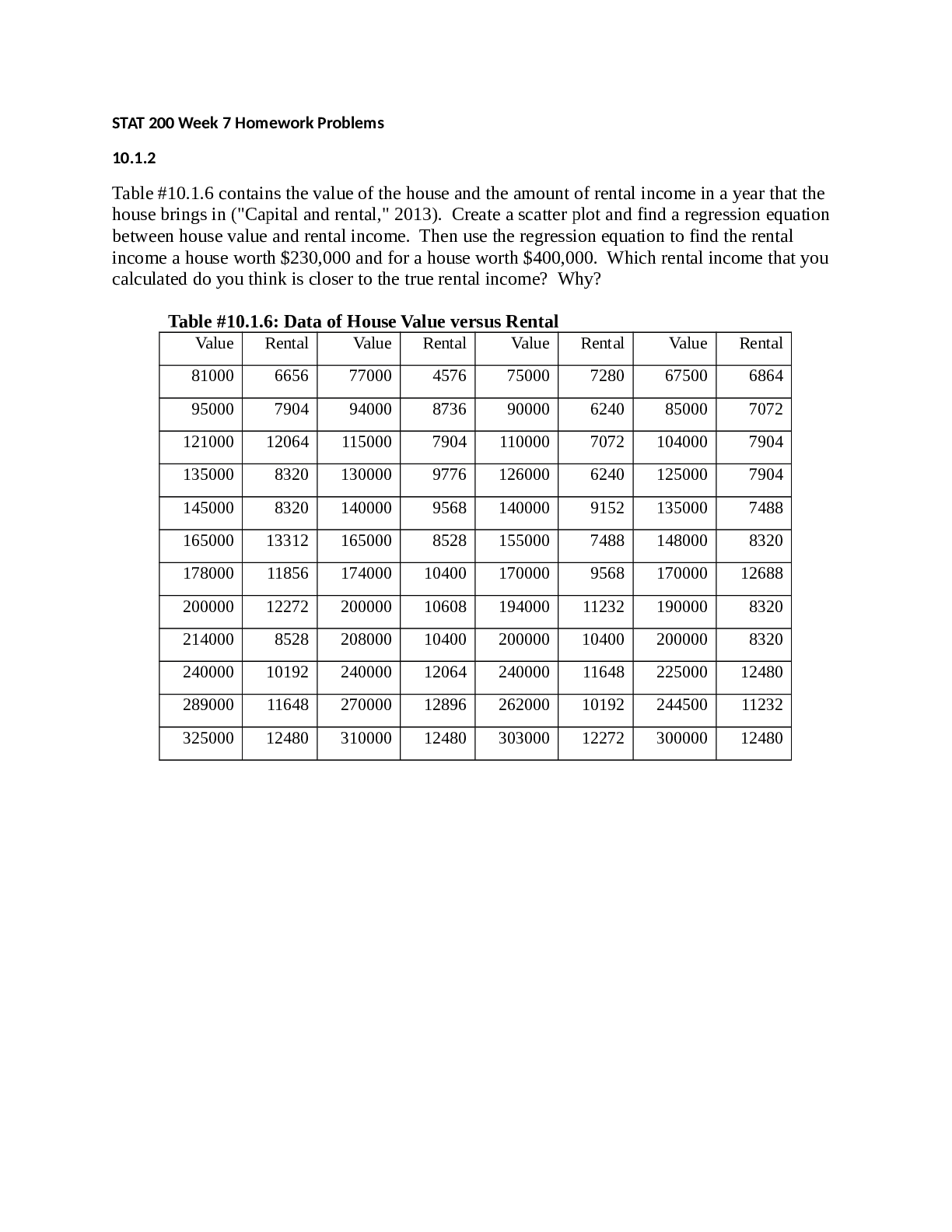
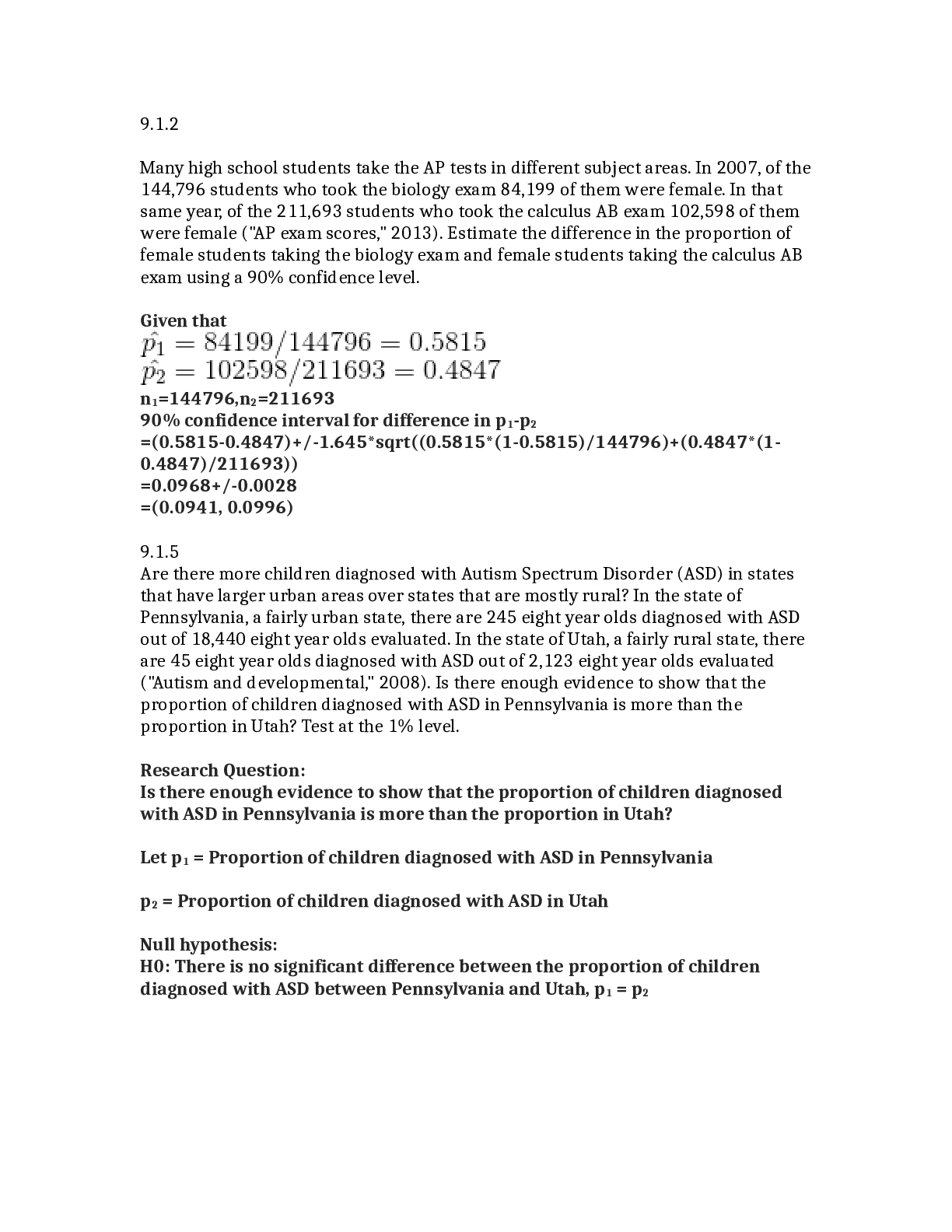
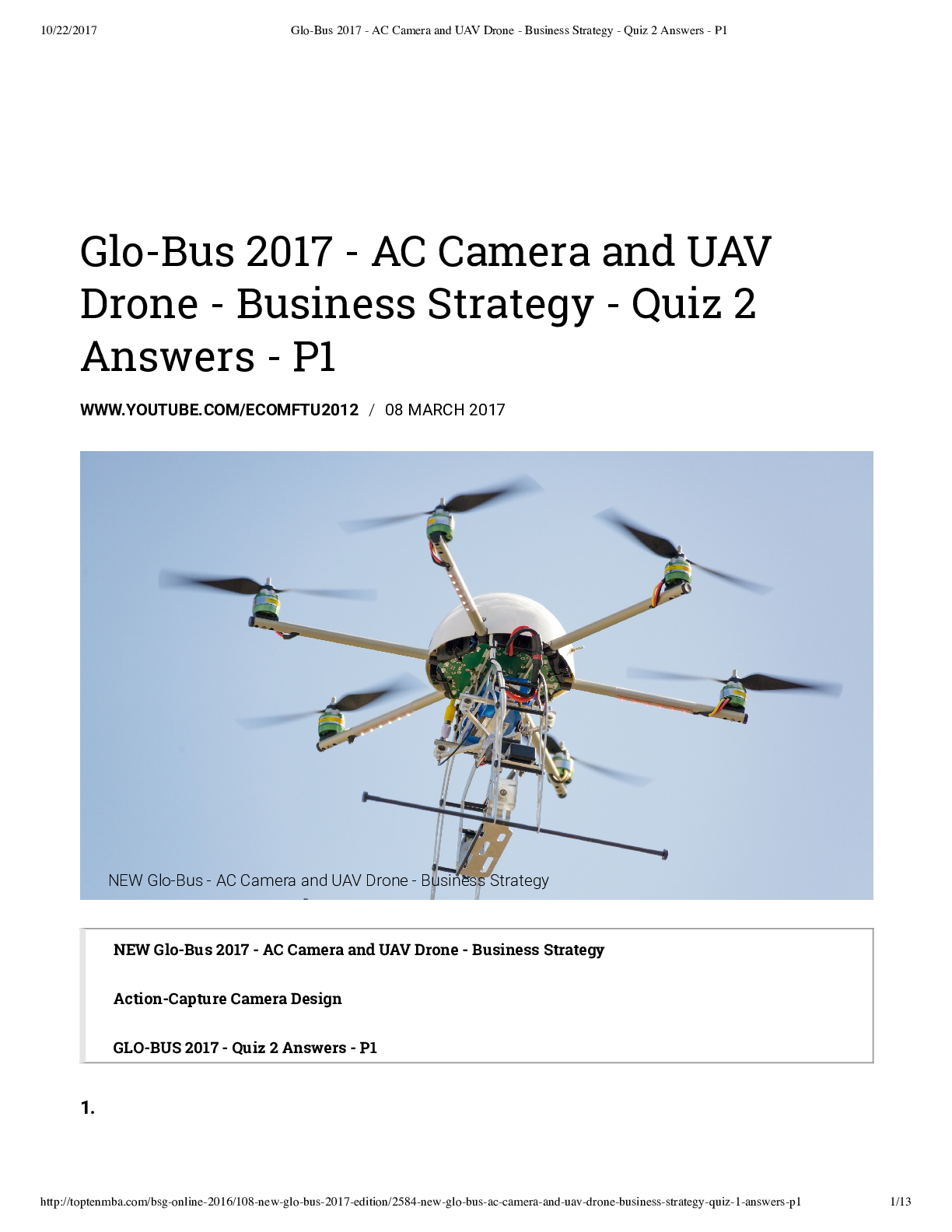


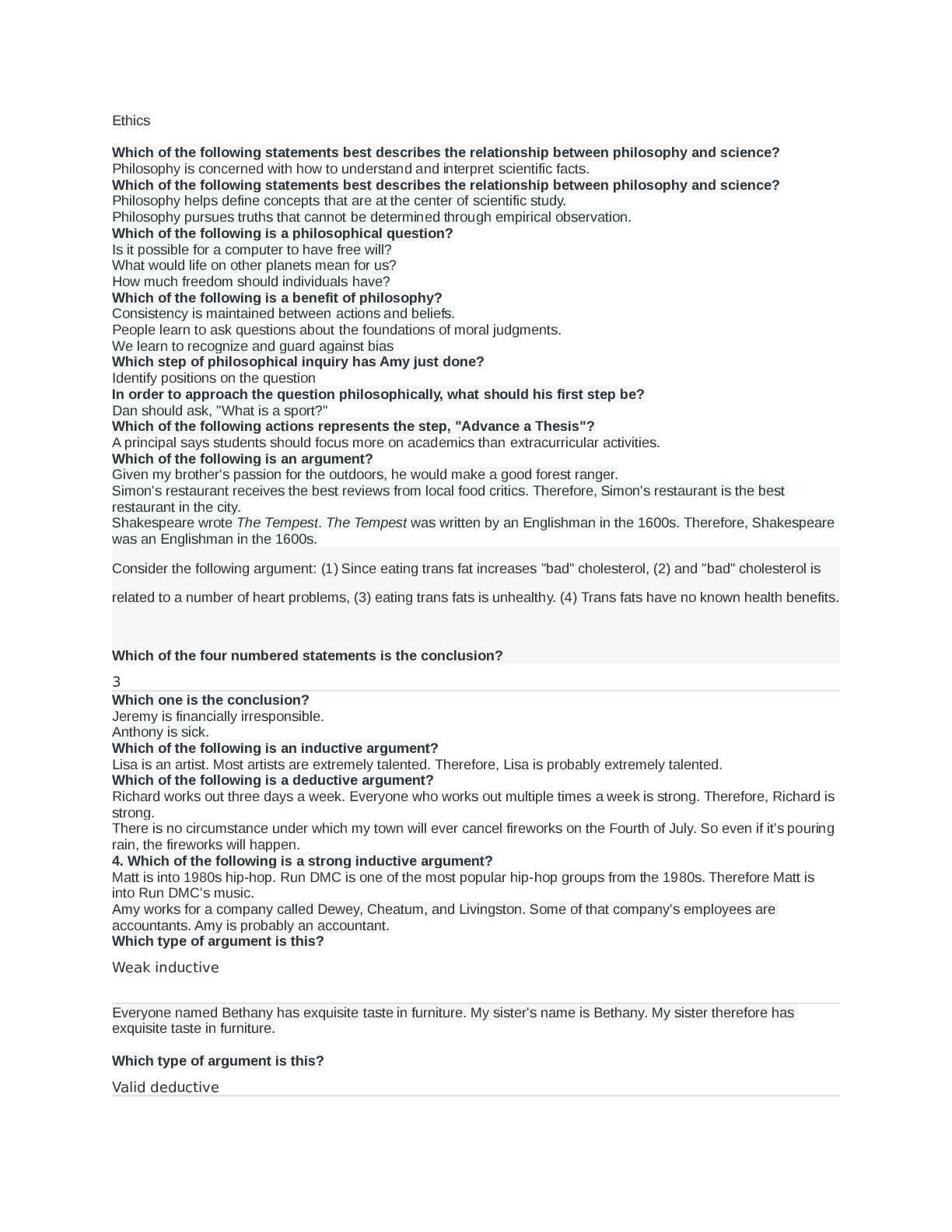

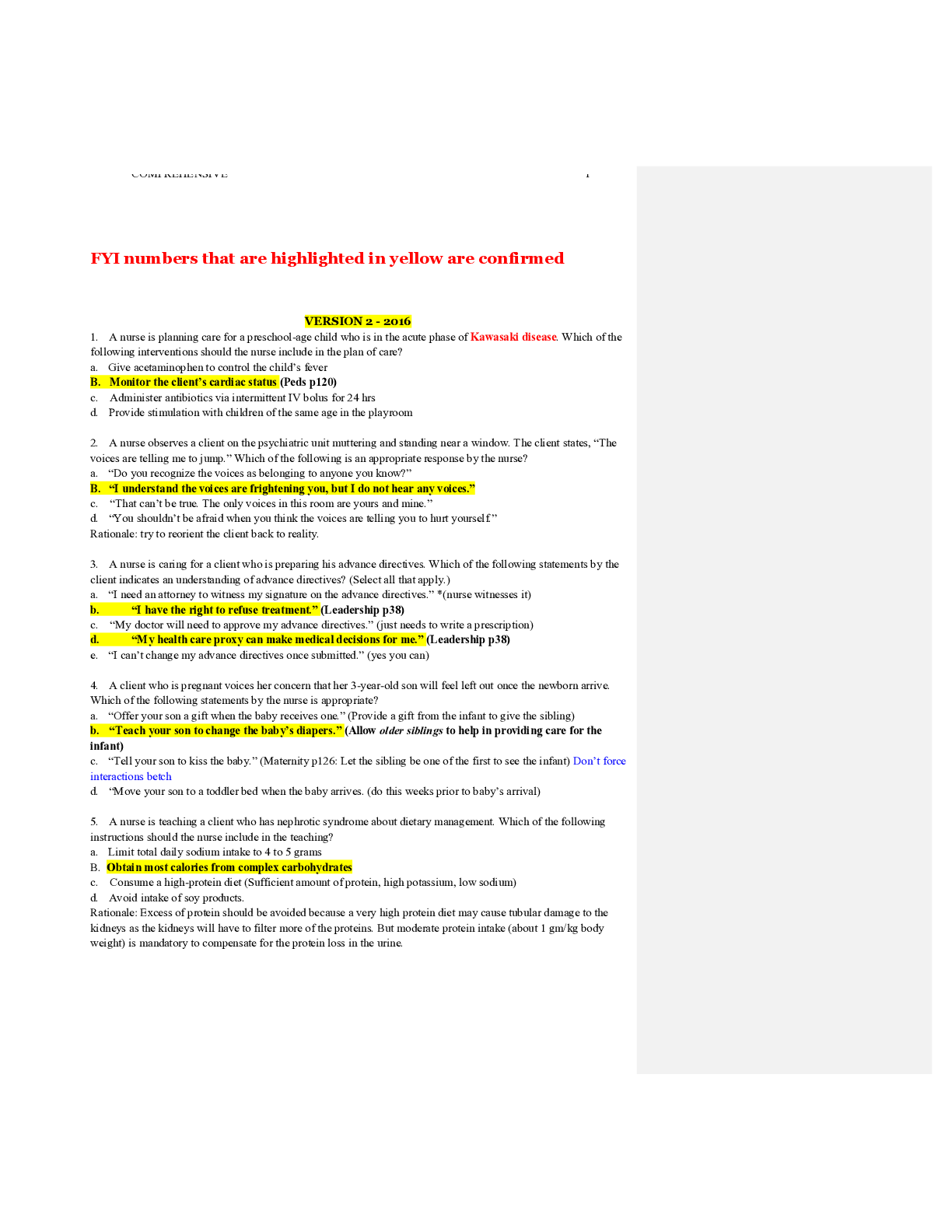
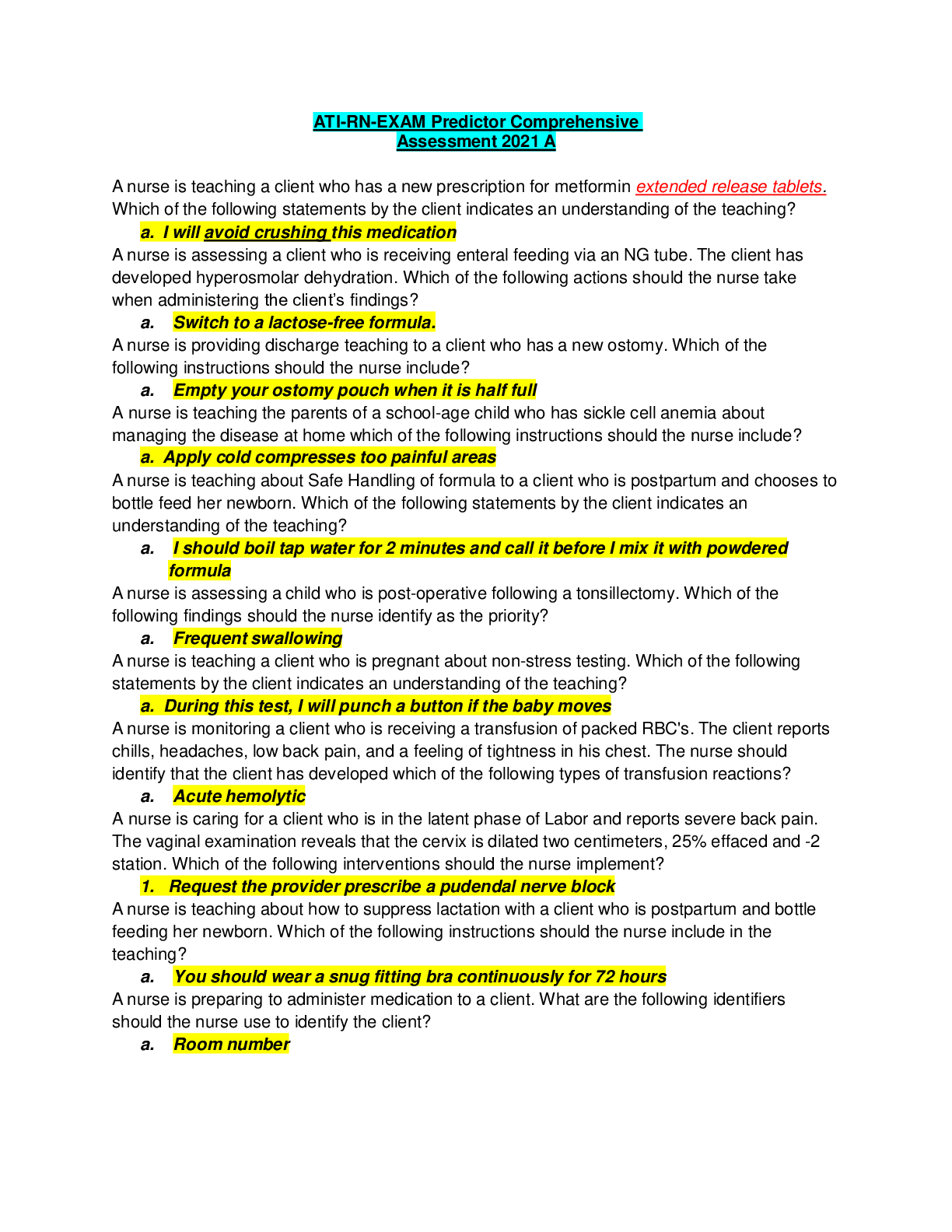



.png)
.png)
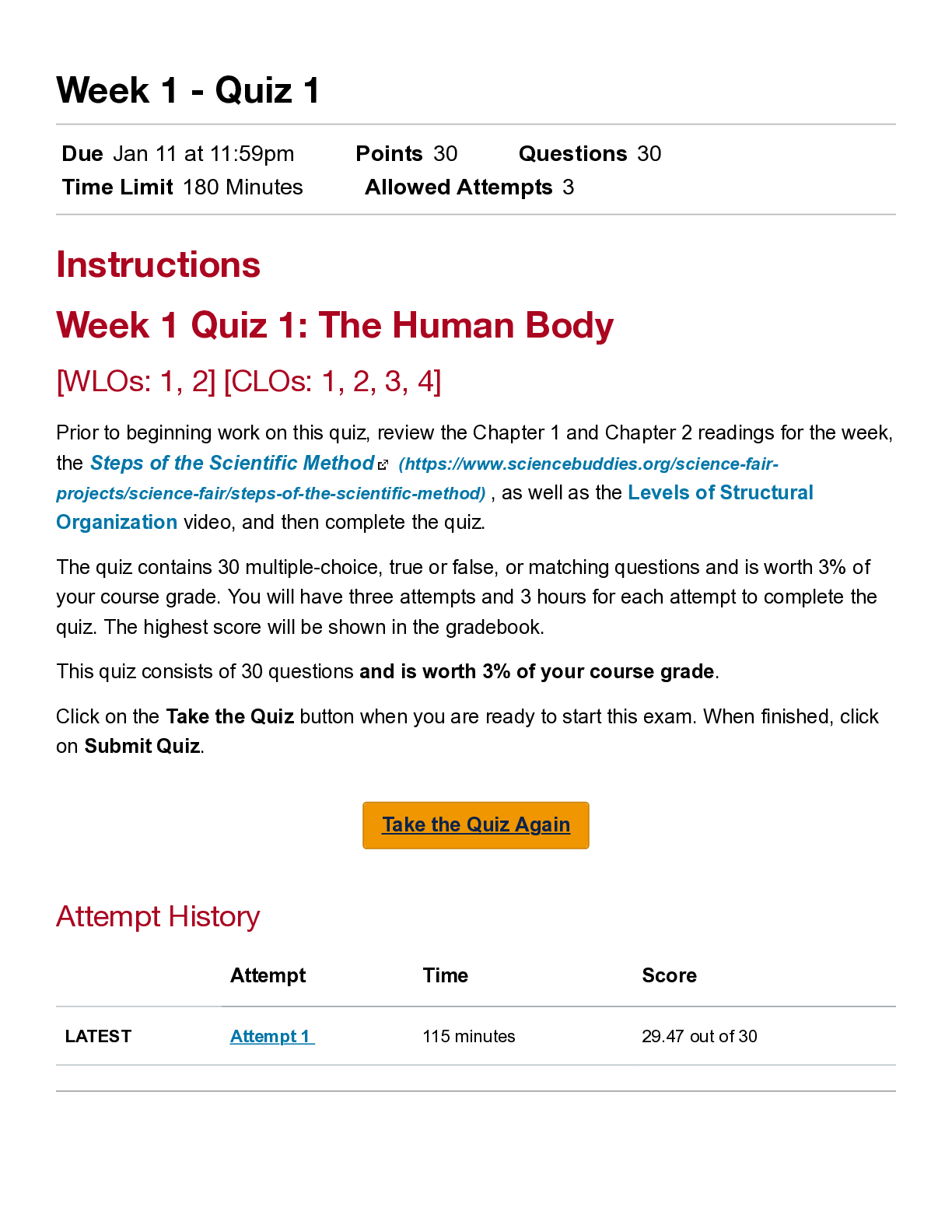


.png)

.png)


